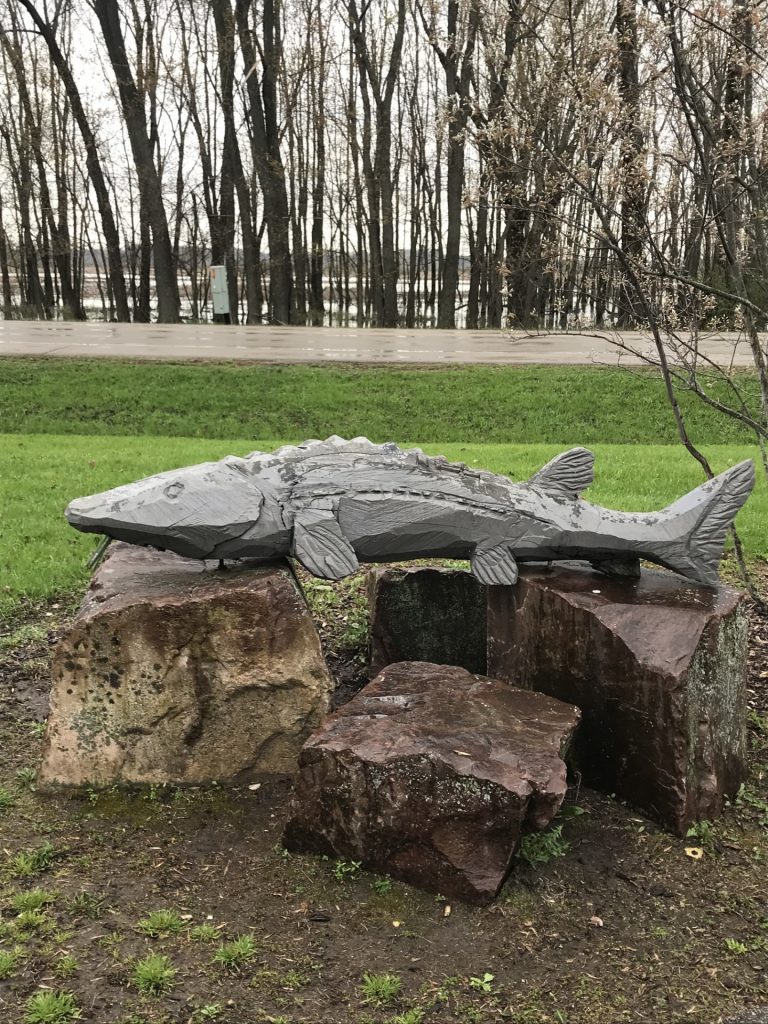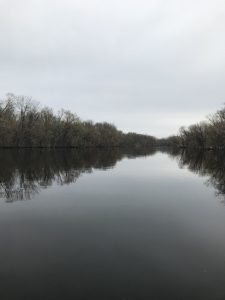
A large wooden sturgeon greets visitors at the beginning of the Wolf River Sturgeon Trail. Credit: Jenna Mertz, Wisconsin Sea Grant
Even prior to beginning my new job at Sea Grant in April—an organization with no lack of enthusiasm for fish—I had a soft spot for lake sturgeon, Wisconsin’s largest and longest-living fish. Surpassing six feet, they are longer than I am tall; living well beyond 100 years, they are older than I’ll ever be. Like redwood trees, sturgeon compel you to contemplate the lives and stories of creatures whose size and age greatly exceed your own, and I’ve always wanted to be near one.
Luckily, living in Wisconsin, I didn’t have to travel far to feel chastened by the complexity of the universe. I just needed to get to Lake Winnebago or one of its tributaries, which have some of the healthiest sturgeon populations in North America. So, on May 5, at the suggestion of my colleague, Bonnie, we drove two hours north of Madison to the Wolf River in New London to see sturgeon spawn.

Jenna Mertz. Credit: Wisconsin Sea Grant
Spawning in the Lake Winnebago system usually occurs mid-April through mid-May once water temperatures reach the mid-50s. Sturgeon will then swim upstream to lay their eggs in the rocky shallows of the Wolf, Peshtigo and Lower Fox rivers, where people can catch glimpses of them thrashing along the shoreline. But spawning can be touch-and-go. Changeable weather and water levels affect when and where they spawn and how well you can see them.
To stay apprised of sturgeon activity and ensure the best chance of seeing one, I signed up for daily reports from the Wisconsin Department of Natural Resources. Emails detailed the outlook for the day—where the sturgeon were spawning, where they weren’t and whether they were just cruising. And the stars, it seemed, were finally beginning to align. After fizzling in mid-April after a bout of freezing temps, spawning was ramping up again. By early May, we were experiencing a steady and seasonally appropriate warm-up, and it seemed the sweet mid-50s range was here to stay. I was hopeful.
But nobody else was, apparently. The parking lot near the river was vacant except for a white pickup idling near the porta-potties. The riverwalk, too, was empty. I began to feel concerned that the lack of onlookers meant a lack of sturgeon. Perhaps they hadn’t read the latest fish report? A light rain streaked the car windows—perhaps it was the weather? Bonnie and I grabbed our rain gear and headed to the river.
The water was high and dark. We walked slowly along the path, peering into the shallow water between the large, blond rocks along the shoreline. I was looking for a splashing tail, a dorsal fin, a shadow that moved. People who had seen the spawn described a river armored with fish from bank to bank, but I saw nothing. Was I not peering hard enough? Was it physically possible to peer harder?
And then, a flash. Out of the corner of my eye, a large white belly flipped skyward. I turned to look, but I was too late. The creature had sunk back into the water, and the river, unruffled, resumed its flow.

The Wolf River in New London, Wisconsin. Credit: Jenna Mertz, Wisconsin Sea Grant
“That was a sturgeon, right?” I asked. Bonnie had seen it too. Energized, we continued walking, stopping to inspect the river at each overlook. Leaves, pollen and the occasional twig rolled past. A school of minnows hovered just beneath the surface, but nothing larger than my pinkie finger came into view.
As we waited, I couldn’t shake the feeling that, just beyond sight, the river was thrumming with sturgeon; that if I could dip my hand in, I’d feel the jostling of all those big, ancient fish. But I couldn’t. It was as simple as that. Above water, the birds chattered as we walked back to the car.
In the parking lot, the owner of the white pickup rolled down the window to ask us about our luck. A member of the Sturgeon Guard, he was stationed on the river to educate folks about the fish and to prevent poaching. We were a bit early, he thought, and the water was high. He had talked to the local bait shop and offered us their tip: next week on Wednesday, the fish would peak.
With yet another prediction in hand, we drove back home. I reminded myself that my most memorable wildlife encounters have been unplanned: crossing paths with a black bear in a city park, finding a cecropia moth at a highway rest stop. My agenda couldn’t compel a sturgeon to the surface, nor could it make me privy to their world beneath the water. Which is why it feels so thrilling when it happens—when you’re granted a glimpse of a life other than your own.


